It is the month of May and spring has finally taken over from winter in New England. With the woods turning green again, color has returned to the landscape. Most of the creeks and brooks that crisscross the region and give rise to hundreds of waterfalls are flowing reasonably well. Together this combination of silver and fluorescent (almost) green highlights the effervescence of spring and I, together with a friend, decided to explore this juxtaposition one weekend at a
time.

Nikon F100 with Velvia 50, Nikkor 24-120mm f/4. 2.5 seconds, f/11, scanned with Nikon LS-5000
This is a travelogue of my first excursion into the woods of Connecticut and Massachusetts photographing their hidden gems aka waterfalls. It is appropriate at this moment to give credit to this excellent resource (and their book in print), which we used exclusively during our quest. I carried a Nikon F100 loaded with Fuji Velvia 50 and three lenses: 18-35mm, 24-120mm f/4 and 70-200mm f/4, each with a circular polarizer. In the end the 24-120mm proved more than adequate and I used it 99% of the time. I also carried a tripod, which is an absolute necessity for long exposures that are almost guaranteed inside dense forests with an ISO 50 film.
We started with Pitcher Falls, a 12 feet punchbowl about two hours west of Boston. A quick 20 min hike took us to a cascade and then 5 minutes further downstream to the Pitcher Falls. Instead of scrambling to the base of the waterfalls, I decided to make photographs with a high vantage point to capture the lovely forest in the background. The conditions were near ideal cloudy skies (soft even lighting) and no wind.

Nikon F100 with Velvia 50, Nikkor 24-120mm f/4. Several seconds, f/11, scanned with Nikon LS-5000
Next, we visited Goldmine Brook Falls situated in the Chester-Blandford State Forest in the town of Chester, Massachusetts. This picturesque waterfall is only about 0.1 mile hike/scramble from the road and can be easily missed. I took time to set my composition and waited for a little cloud to fly over the mid-day sun- the light was soft momentarily, colors came live again and I tripped the shutter.
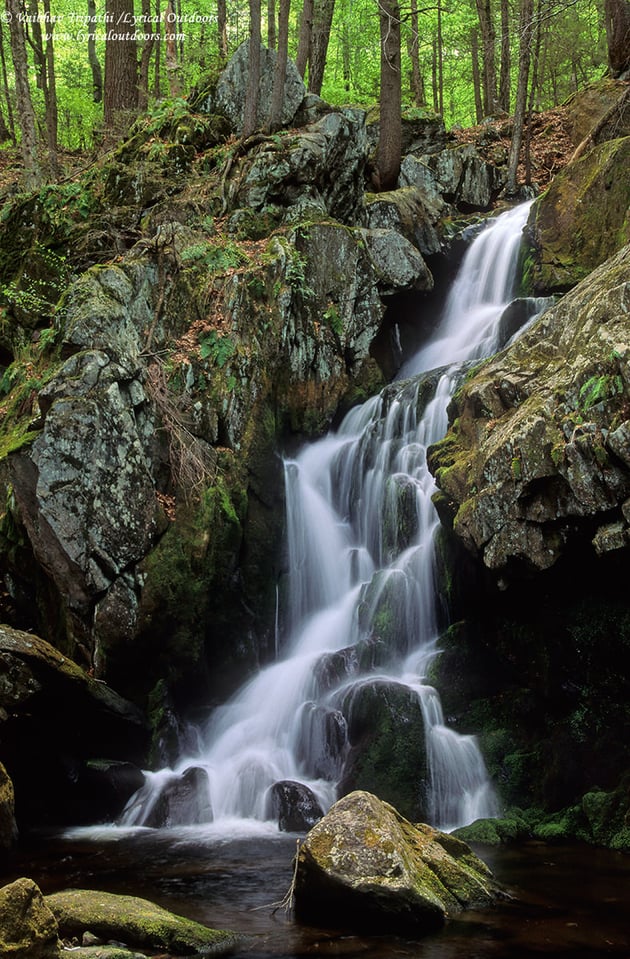
Nikon F100 with Velvia 50, Nikkor 24-120mm f/4, 2.5 seconds, f/16, scanned with Nikon LS-5000
After Goldmine brook falls, we made a quick stop at the nearby Sanderson Brook Falls and then drove to Mt. Everett State Reservation in western Massachusetts. Here the beautiful Race Brook forms 5 waterfalls and the place is a joy to explore and photograph. The trails are a bit steep and tricky though, and it’s easy to lose directions (we took wrong trails twice).
By the time we reached the base of second Race Brook Falls, it was late afternoon and the cloud cover had returned. Once again, I had near ideal conditions to photograph. Scrambling further up brought us to a series of cascades. The moss here was really green and I took advantage of the soft light to capture the color juxtaposed with silky water.

Nikon F100 with Velvia 50, Nikkor 24-120mm f/4, several seconds, f/11, scanned with Nikon LS-5000

Nikon F100 with Velvia 50, Nikkor 24-120mm f/4, several seconds, f/16, scanned with Nikon LS-5000
We camped overnight at Macedonia Brook State Park near the town of Kent in Connecticut, which is about 15 minutes’ drive from the famed Kent Falls. Camping this close gave us an opportunity to visit this beautiful series of cascades (250 feet total drop) early next morning and have the place to ourselves. Here, a trail follows the cascades to the top, and as one gains
height, a new tier of tumbling water is revealed, each as picturesque as the other. Finally at the top, you can appreciate a bird’s eye view of the Kent Falls Brook.

Nikon F100 with Velvia 50, Nikkor 24-120mm f/4, 4 seconds, f/16, scanned with Nikon LS-5000

Nikon F100 with Velvia 50, Nikkor 24-120mm f/4, several seconds, f/11, scanned with Nikon LS-5000
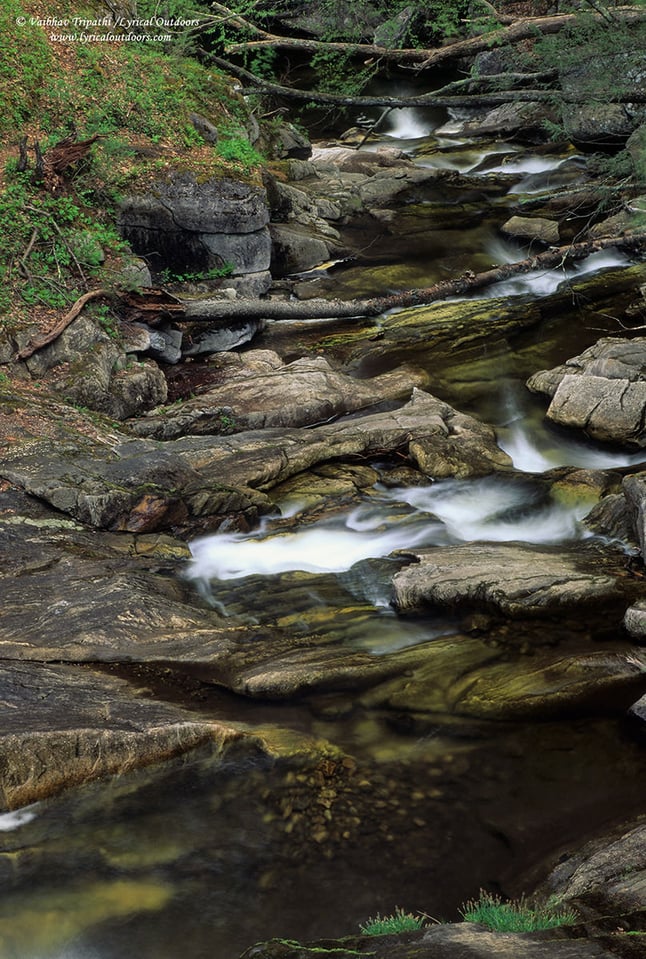
Nikon F100 with Velvia 50, Nikkor 24-120mm f/4, 4 seconds, f/11, scanned with Nikon LS-5000
Our next stop was Dean’s Ravine Falls, which is about 40 minutes north of Kent Falls, near the town of Cannan in Connecticut. With the light not being as cooperative as the day before (harsh mid-day sun), I switched to isolating few areas that were in shade. Same was true at Campbell Falls in Campbell Falls State Park at the border of Massachusetts and Connecticut (our next pit stop).

Nikon F100 with Velvia 50, Nikkor 24-120mm f/4, several seconds, f/16, scanned with Nikon LS-5000
The final destination in our itinerary, before heading back to Boston was the Enders State Forest in Connecticut, which houses an exceptional collection of five diverse waterfalls collectively referred to as the Enders Falls. It was a hot afternoon, the lighting was harsh and on top of that the area was full of people – not so good for waterfall photography, but we endured.
As time progressed, the number of people steadily reduced as well as the light kept getting better for one waterfall after another. First, I photographed the not so remarkable second Enders Falls and then the fourth. Eventually, the light was just right to photograph the third Enders Falls with the composition I had envisioned while waiting earlier – easily one of my favorite images from the trip.
Overall, it was a great satisfaction to photograph something relatively less known. We enjoyed the driving/hiking/exploring over the weekend so much that we did a repeat trip the next weekend, this time focused solely on western Massachusetts. I still do not have developed film from this second excursion but stay tuned for part II.

Nikon F100 with Velvia 50, Nikkor 24-120mm f/4, several seconds, f/11, scanned with Nikon LS-5000

Nikon F100 with Velvia 50, Nikkor 24-120mm f/4. 4 seconds, f/11, scanned with Nikon LS-5000
For the second part of this article, my focus were the forests of Western Massachusetts, especially those around Route 2 West from Boston. This freeway is also known as the Mohawk Scenic Byway and is a very beautiful drive once you get little beyond the Greater Boston area.

Nikon F100 with Velvia 50, Nikkor 18-35mm. 60 seconds, f/16, scanned with Nikon LS-5000
Just like last time we relied upon New England Waterfalls website (and their book in print), as our main resource. I again carried a Nikon F100 loaded with Fuji Velvia 50 and three lenses: 18-35mm, 24-120mm f/4 and 70-200mm f/4. Circular polarizers and a sturdy tripod once more were the most valuable accessory to ensure rich colors (cut reflections) and no camera shake (long exposures).
We started with Doane’s falls in the town of Royalston. The prominent (most well-known) waterfall here in just a short walk from the road. In addition, there are beautiful cascades further downstream and one can easily spend few hours photographing here. It was a cloudy morning with calm winds- ideal conditions for photographing the green foliage with flowing water. I made several images and two of my favorites are presented below.

Nikon F100 with Velvia 50, Nikkor 24-120mm f/4. Several seconds, f/11, scanned with Nikon LS-5000
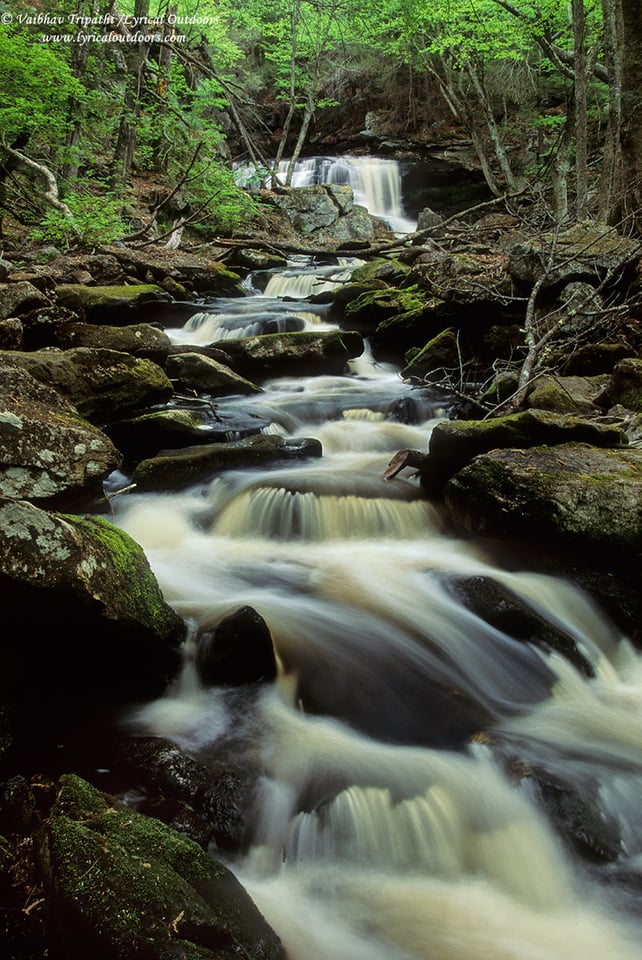
Nikon F100 with Velvia 50, Nikkor 18-35mm. Several seconds, f/11, scanned with Nikon LS-5000
Our next destination was the 80 feet high Royalston Falls, which is rather close to Doane’s Falls area. After 15 minutes of drive to the trailhead, it was a one-mile hike to this waterfall. On the way we walked through a dense beautiful forest next to Falls Brook. Since May was really dry in New England this year, the water was relatively low. We found some interesting reflections upstream from the waterfalls, but the waterfall itself was not much of a spectacle (a local hiker informed us that mid-April is usually a better time to visit as the creek is roaring with snowmelt). Here, I decided to cut out the dark pool and gorge at the bottom and include more of the foliage beside/behind the waterfall. I also chose a focal length of around 50-55mm to allow for a little telephoto compression.
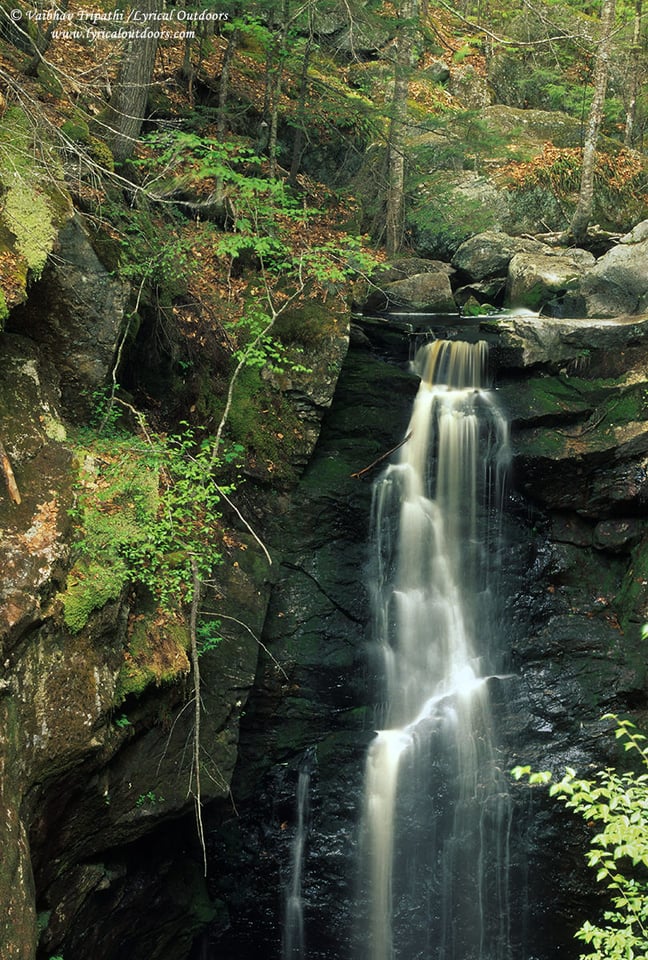
Nikon F100 with Velvia 50, Nikkor 24-120mm. 4 seconds, f/16, scanned with Nikon LS-5000

Nikon F100 with Velvia 50, Nikkor 24-120mm. 6 seconds, f/16, scanned with Nikon LS-5000
Our next destination was Bear’s Den Falls formed by the middle branch of Swift River, in the town of New Salem. Located further west on route 2 from our first stop, this appeared to be a local favorite as we found several cars in the parking lot. It is a short 0.2 mile hike to the main waterfalls and even though the plunge is not very high, the overall setting is quite picturesque. I first chose to use a very wide perspective and photographed the main cascade from up close. Then with little scrambling, I managed to find a high enough albeit a bit precarious vista to make a photo showing a bird’s eye view of the area. The latter image has a painterly feel to it and captures the sense of the place quite well.

Nikon F100 with Velvia 50, Nikkor 18-35mm. 6 seconds, f/16, scanned with Nikon LS-5000

Nikon F100 with Velvia 50, Nikkor 24-120mm f/4, several seconds, f/11, scanned with Nikon LS-5000
After Bear’s Den Falls, we drove further west on Route 2 towards the town of North Adams. The drive is quite scenic with Deerfield River meandering beside the road. Our plan was to camp overnight alongside Cold River in Mohawk State Forest and explore the waterfalls and forests in the region namely Tannery Falls, Twin Cascades, Parker Brook Falls and Wahconah Falls.
Since Tannery Falls was close to our campground, we thought of visiting it before dark only to find that the spur road which connected Route 2 to Savoy Mountain State Forest (abode of Tannery Falls) is unpassable. The longer route needed 45 minutes of drive, so instead we drove to the Twin Cascades trailhead, which was about 15 minutes by car from our campsite. It turned out to be a good decision.
The Twin Cascades area is really cool. The trail is easily found (starts just beside a private railroad tunnel so please avoid trespassing) and though it is steep and really narrow in certain places, those sections are easily passed. The air here has a very fresh feel to it and the pristine Cascade Brook has cut a narrow gorge with some sections so clean that it just feels a perfect place to soak your feet and let water flow over timelessly. The hike ends at a point where one can see two waterfalls merging (like a Y) to make one stream. It is also a good place to see petrified wood, a treat for geology lovers.

Nikon F100 with Velvia 50, Nikkor 18-35mm, 45 seconds, f/8, scanned with Nikon LS-5000

Nikon F100 with Velvia 50, Nikkor 18-35mm, 60 seconds, f/8, scanned with Nikon LS-5000
The next morning, we took the long route to Tannery Falls. Since, we were plotting the way using maps (as many roads are dirt and impassable in the area), it took us quite a while to reach there. Moreover, a foggy dawn stopped us in our tracks soon after we had started and we spent about half an hour photographing various morning moods. Velvia 50 really works well for such scenes and has rendered the soft, surreal atmosphere very nicely.

Nikon F100 with Velvia 50, Nikkor 24-120mm, few seconds, f/11, scanned with Nikon LS-5000

Nikon F100 with Velvia 50, Nikkor 24-120mm f/4, few seconds, f/11, scanned with Nikon LS-5000

Nikon F100 with Velvia 50, Nikkor 24-120mm f/4, several seconds, f/11, scanned with Nikon LS-5000
By the time, we could find our way to Tannery Falls, it was well past sunrise. Moreover, since the 80 feet high Tannery Falls directly faces the morning sun (no clouds today), the light was already less than ideal. The Parker Brook Falls, which is a little walk from Tannery Falls was in shade and I could make few compositions here. Overall, this area of Savoy Mountain State Forest is a waterfall country. There are several if not dozens little picturesque cascades around and a day with soft even lighting can keep a photographer busy for several hours. I intend to re-visit this area and fulfill the photography potential it has on offer.
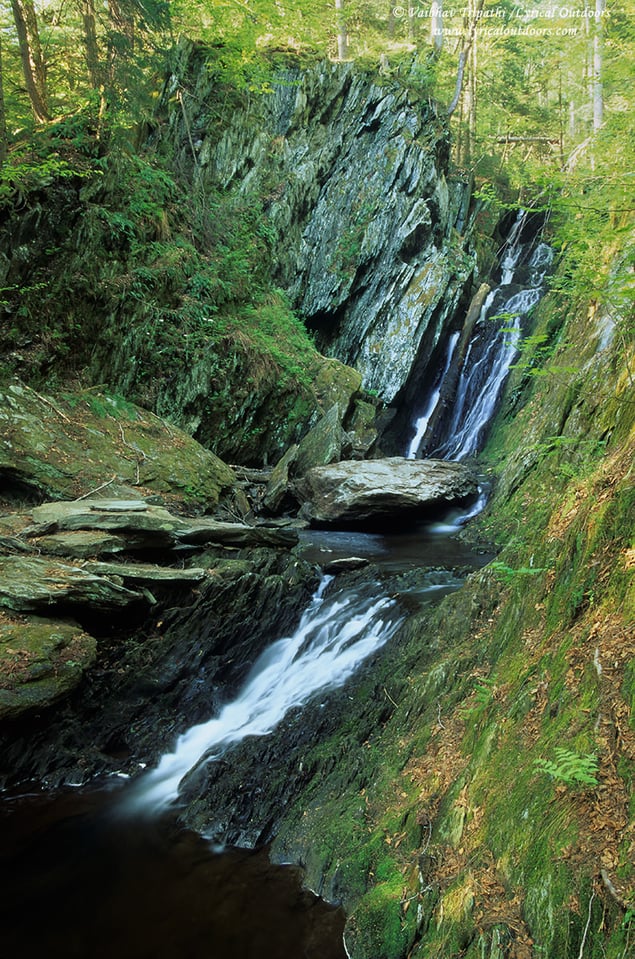
Nikon F100 with Velvia 50, Nikkor 24-120mm f/4, 6 seconds, f/16, scanned with Nikon LS-5000

Nikon F100 with Velvia 50, Nikkor 24-120mm f/4, several seconds, f/16, scanned with Nikon LS-5000

Nikon F100 with Velvia 50, Nikkor 24-120mm f/4, scanned with Nikon LS-5000
After Tannery Falls, we drove back to the campground, broke camp and decided to stop at Wahconah Falls located in Wahconah Falls State Forest, before heading back to Boston. The base of the waterfalls is a short, easy walk from the parking lot and luckily by the time we had reached, there were some puffy clouds in the sky. In such conditions, I followed my usual practice: set up a composition, spot meter the deep shadows (I am interested in) to 1.5 stops below mid tone, wait for a floating cloud to cover the sun and then trip the shutter.
In the end, I must admit that it has been lot of fun exploring and making photos of waterfalls and cascades hidden in forests of New England. After spending quite some time exploring a variety of waterfalls of Massachusetts and Connecticut, I now intend to turn my attention to waterfalls in New Hampshire, Vermont and Maine. With the summer just beginning to set in northern New England, it should be fun. Stay tuned!

Nikon F100 with Velvia 50, Nikkor 24-120mm f/4, 3 seconds, f/11, scanned with Nikon LS-5000

Nikon F100 with Velvia 50, Nikkor 18-35mm, 8 seconds, f/16, scanned with Nikon LS-5000
I am ready to pull out my F4as shoot some film.
Why is water all phomey and vapour like? Is the natural picture of the falls (without any special effects) not so good looking?
Wow, what beauty and so skillfully caricatured — GREAT job! Makes me want to visit all these delightful falls.
Vaibhav:
Nice work on those waterfalls. Your work inspires me to get out there and shoot again with my beloved F-100. Can’t afford a pro-level DSLR so use what I have (some good primes). Would love to shoot some California falls, but this season they are largely dehydrated.
Yosemite has some marvelous (and high) falls; have shot some there and hope to do more.
Fantastic photos!
I love film, it just has a different quality, an artistic one. :)
Vaibhav, great photos again.
Welcome to Western MA and I was just at Enders this Monday. Your pics look very similar to the ones on my Flickr account. I hope you had a chance to visit Bash Bish Falls which I believe is the tallest waterfall in MA.
These remind me how gourgous Velvia is.
Hi Dave, I looked at the flickr account. You have some good photos in there. Enders was great and I would for sure like to visit again, preferably early morning to beat the crowds.
Beautiful photos, look forward to Part 2.
Thanks Jim. I will be getting the film developed sometime next week. Stay tuned :)
Great images…and love the Velvia colors.
I love the Velvia colors too especially the way it has rendered the Spring greens.
Vaibhav, thank you for sharing your passion. Wonderful images. I’ll soon be moving to an area in Virginia surrounded by six state parks and several rivers. I don’t yet know if there are any waterfalls but I intend to explore each park one at a time.
Hi Mike, I am sure Virginia will be beautiful. Thanks for looking and am glad you liked the photos.